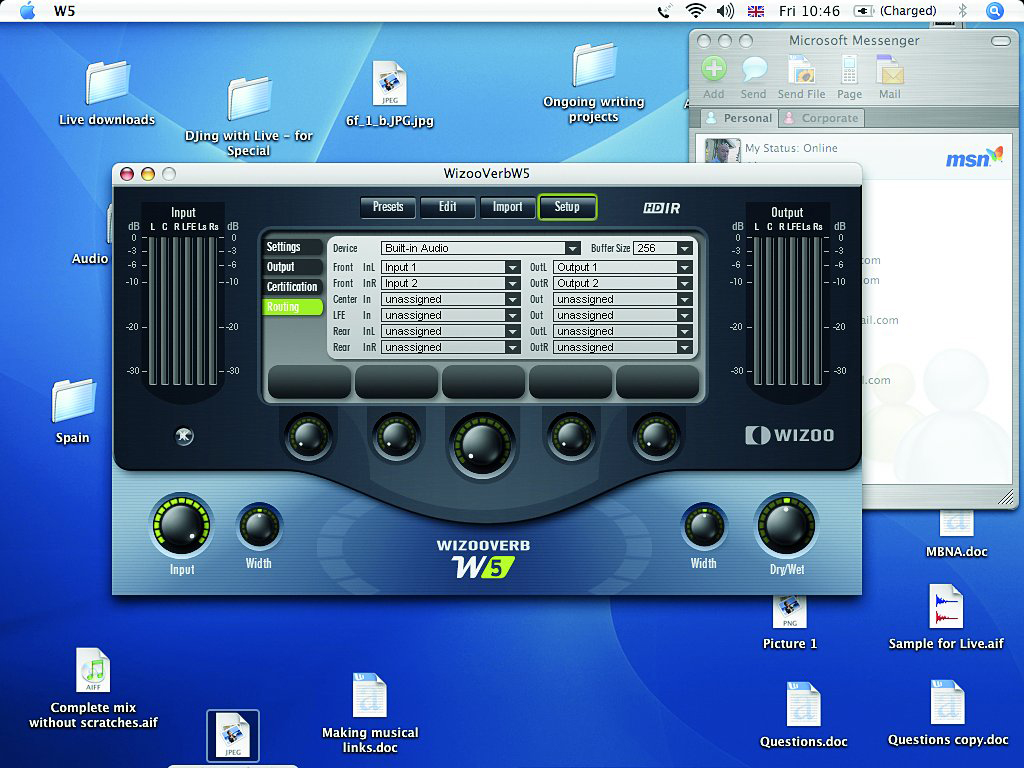MusicRadar Verdict
Absolutely amazing. The occasional glitch can't dampen the shine.
Pros
- +
Stunning sound. Fantastic presets. Unique features. Great interface. Not too CPU hungry.
Cons
- -
One or two bugs need to be ironed out. Why no AU version for Mac?
MusicRadar's got your back

The Wizoo interface.

Take control of the advanced techniques.

Reverb galore.

Recreate actual acoustic spaces.
WizooVerb W5 is a sublime sounding 5.1 surround reverb that utilises two advanced techniques. The first of these is HDIR: this stands for High Definition Impulse Response and is essentially a very detailed and spatially enabled version of the standard convolution reverb principle. The second is a more algorithmic process (though Wizoo claim it´s not simply the standard delay and filter process at work) called AIR (or Acoustic Impulse Rendition).
The former is designed primarily for recreating actual acoustic spaces, while the latter is far less CPU-intensive and offers more programming flexibility. Both processes sound absolutely mind-blowing -- you really can close you eyes and pick out three-dimensional spaces with your ears. Even in basic stereo mode, W5 is a joy to listen to, and all of its proud owners will undoubtedly use it on their more conventional 2-channel mixes too.
´Verb garden W5´s brilliant engine is backed up by a selection of excellent presets and HD impulse responses that are gathered in glorious surround format for complete spatial accuracy. The presets are also clearly labelled and even offer suggested uses, so you can avoid the silliness of placing a rock drum kit in a virtual cathedral dome.
The straightforward GUI enables you to get in-depth with your editing and construct original patches (all your changes are easily stored). The sub-menus for each window in the main display are incredibly easy to navigate -- a fact that belies their power and detail. What´s more, many of the subsections, such as the delay area, have their own sets of presets.
Neat touches
In truth, there are just too many neat touches to mention, but one critical area is the LFE section (the channel that drives the subwoofer). This enables you to split the signal and direct only the upper section to the satellites in your monitoring setup and only the bass to the sub. Alternatively, you can use the LFE volume channel to remove any reverb from your bass channel (excessive reverb on the bass is generally the reserve of film soundtracks).
Head round to WizooVerb´s virtual backside and you´ll find some fantastic routing options. You can choose such useful configurations as stereo- or mono-to-5.1 processing, and 5.1-to-5.1 processing. The front panel level meters and controls keep things in check, while useful global controls such as Width (at both the input and output stages) make real-time manipulation and hands-on editing perfectly simple.
Want all the hottest music and gear news, reviews, deals, features and more, direct to your inbox? Sign up here.
Another welcome feature is the standalone version. This enables you to turn your laptop into a dedicated reverb unit for use in a live environment. Granted, you might not need the 5.1 functionality when you´re on stage, but even the stereo sound is pretty astounding.
Glitches
W5 does have a few shortcomings -- these largely relate to certain bugs and glitches. One of the most annoying translates into silence at the output stage when you use the plug-in in Logic, even though all of the input and output level meters indicate that strong signals are passing through.
The unit does emit a popping click upon playback, however -- much like when there´s a soundcard driver issue. The only way to rectify this problem is to change the preset or edit certain parameters, at which point the sound returns. Another such irritating bug involves the BPM syncing of the delay section, which can sometimes flicker wildly between 120 and the current project tempo.
The only other negative thing we can say about the WizooVerb W5 is that the Mac version is VST only, so some messing about with a VST-AU adapter is required if you´re a Logic user. It´s not a massive problem, but it still feels like an imposition in these enlightened times. But fair´s fair, all these issues will probably be resolved in an update, and none of them is a deal breaker anyway.
What´s more, when you stack these gripes up against the superb interface, the stunning routable and editable feature set, the lovingly crafted selection of presets and fantastic reverb sound, the clouds just seem to float away. This is one of the clearest and most intuitive reverb units there is, and it´s also heavy on power and features.
MusicRadar is the number one website for music-makers of all kinds, be they guitarists, drummers, keyboard players, DJs or producers...
- GEAR: We help musicians find the best gear with top-ranking gear round-ups and high-quality, authoritative reviews by a wide team of highly experienced experts.
- TIPS: We also provide tuition, from bite-sized tips to advanced work-outs and guidance from recognised musicians and stars.
- STARS: We talk to musicians and stars about their creative processes, and the nuts and bolts of their gear and technique. We give fans an insight into the craft of music-making that no other music website can.
